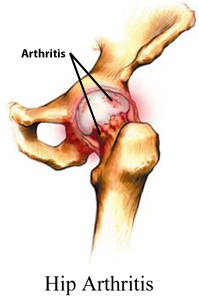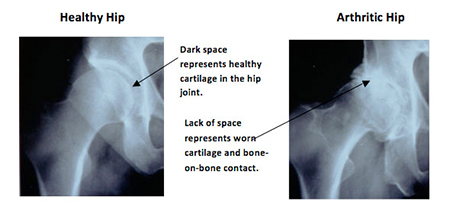Arthritic Hip
What is Arthritis?
Arthritis is a term that is defined as inflammation of the joint and used to describe over 100 different conditions that can affect the human body. Arthritis affects millions of Americans each year with symptoms including pain, stiffness, swelling, and loss of motion in affected joints.
There are three types of arthritis that generally affect the hip; osteoarthritis, rheumatoid arthritis and osteonecrosis.
Osteoarthritis of the Hip
Osteoarthritis, the most common form of arthritis, results in the wearing out of the cartilage that protects the bones in the joints. Once cartilage is damaged or destroyed, cartilage cannot repair or replace itself like many other body tissues. Hip cartilage can be compared to the tread of an automobile tire, very durable but susceptible to wear over time. As we age, the tread surface slowly erodes until the underlying bone is exposed. This exposed bone can be painful when the joint moves and bears weight.
Often the cause of arthritis is unknown, but may develop as a result of injury to the joint, excess body weight, or years of wear and tear on the joint cartilage. There is no known cure. The best that doctors can do for patients is to restore motion and reduce pain.
Common symptoms of osteoarthritis of the Hip
- Severe hip pain that limits everyday activity
- Pain in the groin
- Hip pain at night causing sleeplessness
- Chronic swelling of the hip with morning stiffness
- Grinding pain during movement
Rheumatoid Arthritis of the Hip
Rheumatoid arthritis is a systemic inflammatory condition of the joint lining, or synovium where the body’s immunological system attacks healthy tissue, causing inflammation of the joint lining and subsequent joint damage. When rheumatoid arthritis is present, the cartilage is not being provided with enough lubrication and nourishment. This leads to loss of motion, stiffness and pain in the hip.
Osteonecrosis of the Hip
Osteonecrosis, also called Avascular Necrosis (AVN), is a disease that results from lack of blood supply to the bone. It affects the femoral head (the ball at the top of the thighbone) most commonly. As a result of AVN, the bone receives an inadequate blood supply and eventually dies.
Osteonecrosis is most common in people ages 20 to 50 years. It generally results from fracture, dislocation, or another disease process. AVN is typically associated with traumatic injury, such as falling down, excessive alcohol consumption, and steroid use. As the disease progresses, symptoms may include intermittent aching and pain, which can become more severe over time and limit your movement and activity level.
Descriptions provided by The Arthritis Foundation.
All patient education materials are provided by OrthoPatientEd.com and have been reviewed by our Advisory Board of leading Orthopedic Surgeons to ensure accuracy. All materials are provided for informational purposes only and are not intended to be a substitute for medical advice from your orthopedic surgeon. Any medical decisions should be made after consulting a qualified physician.
This site includes links to other websites. OrthoPatientEd.com takes no responsibility for the content or information contained in the linked sites.


